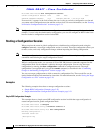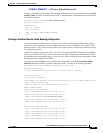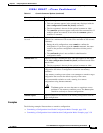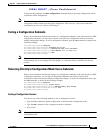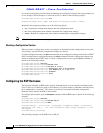
FINAL DRAFT —Cisco Confidential
3-28
Cisco ASR 9000 Series Aggregation Services Router Getting Started Guide
OL-17502-01
Chapter 3 Configuring General Router Features
Managing Configuration Sessions
In the following example, the user configures an interface but does not commit it. After reviewing the
changes to the target configuration with the show configuration command, the user decides to remove
the changes and start over by entering the clear command:
RP/0/RSP0/CPU0:router# configure
RP/0/RSP0/CPU0:router(config)# interface Gi 0/3/0/1
RP/0/RSP0/CPU0:router(config-if)# description this is my interface
RP/0/RSP0/CPU0:router(config-if)# ipv4 address 10.1.1.1 255.0.0.0
RP/0/RSP0/CPU0:router(config-if)# shutdown
RP/0/RSP0/CPU0:router(config-if)# exit
RP/0/RSP0/CPU0:router(config)# show configuration
Building configuration...
interface Gi0/3/0/1
description this is my interface
ipv4 address 10.1.1.1 255.0.0.0
shutdown
end
RP/0/RSP0/CPU0:router(config)# clear
RP/0/RSP0/CPU0:router(config)# show configuration
Building configuration...
end
Committing Changes to the Running Configuration
The changes in the target configuration do not become part of the running configuration until you type
the commit command. When you commit a target configuration, you can use the commit command to
do either of the following:
• Merge the target configuration with the running configuration to create a new running configuration.
• Replace the running configuration with the target configuration.
Note If you try to end a configuration session without saving your changes to the running configuration with
the commit command, you are prompted to save the changes. See the
“Ending a Configuration Session”
section on page 3-31 for more information.
To commit target configuration changes to the running configuration, type the commit command by
itself or with one or more of the options described in
Table 3-5.
Ta ble 3-5 Commit Command Options
Command Description
commit (Default) Merges the target configuration with the running configuration
and commits changes only if all changes in the target configuration pass
the semantic verification process. If any semantic errors are found, none
of the configuration changes takes effect.
commit best-effort Merges the target configuration with the running configuration and
commits only valid changes (best effort). Some configuration changes
might fail due to semantic errors.



